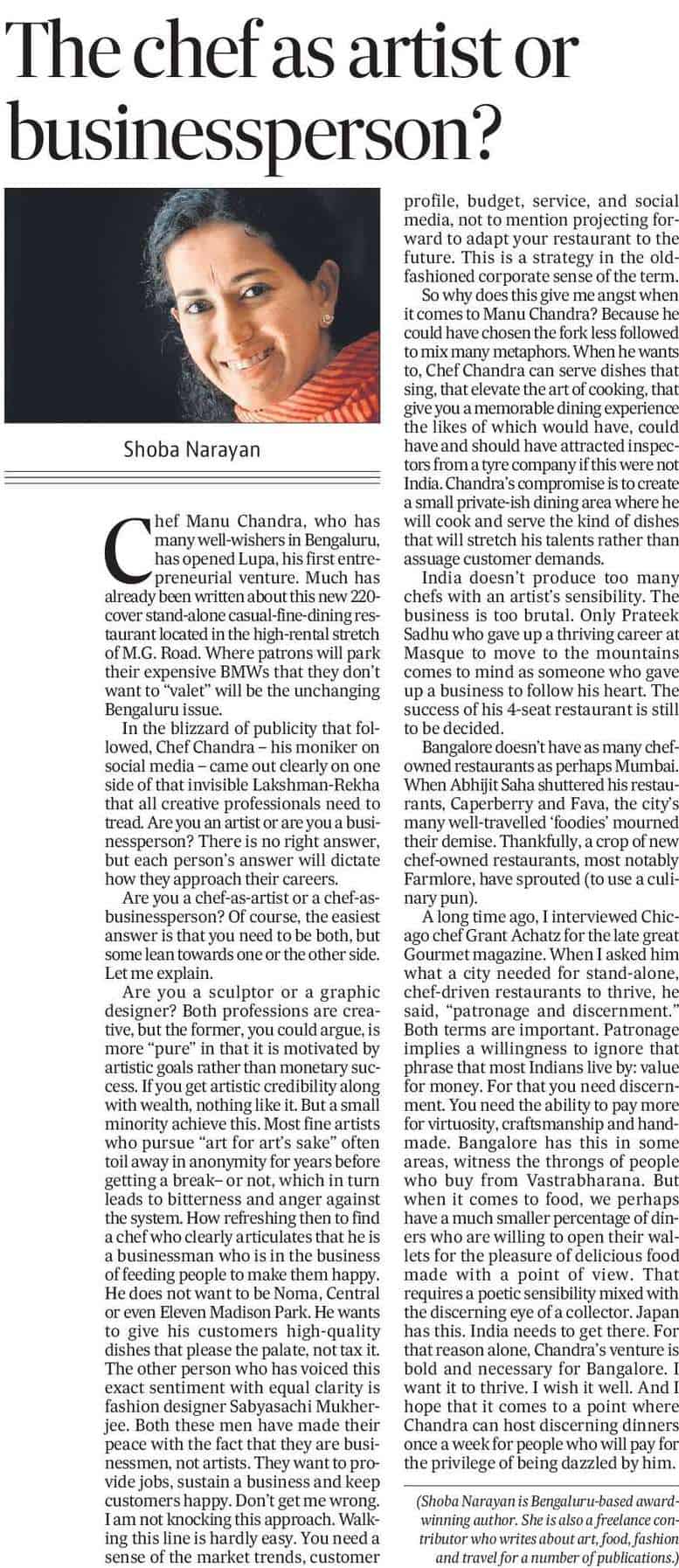Chef Manu Chandra who has many well-wishers in Bangalore has opened Lupa, his first entrepreneurial venture. Much has already been written about this new 220-cover stand-alone casual-fine-dining restaurant located in the high-rental stretch of M.G. Road. Where patrons will park their expensive BMWs that they don’t want to “valet” will be the unchanging Bangalore issue.
In the blizzard of publicity that followed, Chef Chandra– his moniker on social media– came out clearly on one side of that invisible Lakshman-rekha that all creative professionals need to tread. Are you an artist or are you a businessperson? There is no right answer, but each person’s answer will dictate how they approach their careers.
Are you a chef-as-artist or a chef-as-businessperson? Of course, the easiest answer is that you need to be both, but some lean towards one or the other side. Let me explain.

Are you a sculptor or a graphic designer? Both professions are creative but the former, you could argue, is more “pure” in that it is motivated by artistic goals rather than monetary success. If you get artistic credibility along with wealth, nothing like it. But a small minority achieve this. Most fine artists who pursue “art for art’s sake” often toil away in anonymity for years before getting a break– or not, which in turn leads to bitterness and anger against the system.
How refreshing then to find a chef who clearly articulates that he is a businessman who is in the business of feeding people in order to make them happy. He does not want to be Noma, Central or even Eleven Madison Park. He wants to give his customers high-quality dishes that please the palate, not tax it. The other person who has voiced this exact sentiment with equal clarity is fashion designer Sabyasachi Mukherjee. Both these men have made their peace with the fact that they are businessmen not artists. They want to provide jobs, sustain a business and keep customers happy. Don’t get me wrong. I am not knocking this approach. Walking this line is hardly easy. You need a sense of the market trends, customer-profile, budget, service, and social media, not to mention projecting forward to adapt your restaurant to the future. This is strategy in the old-fashioned corporate sense of the term.
So why does this give me angst when it comes to Manu Chandra? Because he could have chosen the fork less followed to mix many metaphors. When he wants to, Chef Chandra can serve dishes that sing, that elevate the art of cooking, that give you a memorable dining experience the likes of which would have, could have and should have attracted inspectors from a tyre company if this were not India. Chandra’s compromise is to create a small private-ish dining area where he will cook and serve the kind of dishes that will stretch his talents rather than assuage customer demands.
India doesn’t produce too many chefs with an artist’s sensibility. The business is too brutal. Only Prateek Sadhu who gave up a thriving career at Masque to move to the mountains comes to mind as someone who gave up a business to follow his heart. The success of his 4-seat restaurant is still to be decided.
Bangalore doesn’t have as many chef-owned restaurants as perhaps Mumbai. When Abhijit Saha shuttered his restaurants, Caperberry and Fava, the city’s many well-travelled ‘foodies’ mourned their demise. Thankfully, a crop of new chef-owned restaurants, most notably Farmlore, have sprouted (to use a culinary pun).
A long time ago, I interviewed Chicago-chef Grant Achatz for the late great Gourmet magazine. When I asked him what a city needed in order for stand-alone, chef-driven restaurants to thrive, he said, “patronage and discernment.” Both terms are important. Patronage implies a willingness to ignore that phrase that most Indians live by: value for money. For that you need discernment. You need the ability to pay more for virtuosity, craftsmanship and handmade. Bangalore has this in some areas, witness the throngs of people who buy from Vastrabharana. But when it comes to food, we perhaps have a much smaller percentage of diners who are willing to open their wallets for the pleasure of delicious food made with a point of view. That requires a poetic sensibility mixed with the discerning eye of a collector. Japan has this. India needs to get there.
I want it to thrive. I wish it well.
And I hope that it comes to a point where Chandra can host discerning dinners once a week to people who will pay for the privilege of being dazzled by him.




Leave A Comment